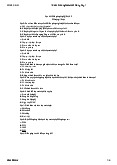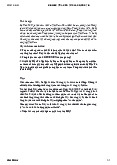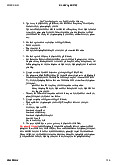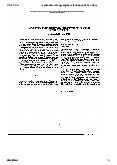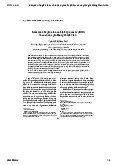












Preview text:
lOMoAR cPSD| 40425501 NOUNS AND NOUN PHRASES I. Nouns:
Definition: Noun = name of anything (people, places or things) 1. Types of nouns:
- According to the reference criterion:
+ Concrete nouns: pen, book, city, country…
• Common: John, Linda, Paris,… + Individual + Collective Proper:
+ Abstract nouns: happiness, education, construction… (states, events, concepts…)
- According to the number criterion: + Countable + Uncountable
• Note: Virtually all non-count nouns can be treated as count-nouns when
used in classificatory senses:
Eg. There are several French wines available.
- According to the word formation criterion: + Simple nouns + Derived nouns + Compound nouns 2. Numbers of nouns: a. Formation of the plural:
- Almost all Ns “s”; e.g. books, pens…
- Ns ending in “ch, sh, x, s, z, o” “es”; e.g. watches, boxes, glasses, buzzes, potatoes, bushes…
- Ns ending in “f, fe” “ves”; e.g. wives, leaves,…
- Ns ending in “y” preceded by a consonant “ies”; e.g. lorries… - Irregular plurals:
+ By changing vowels: man men; goose geese
+ Singular = plural: sheep, deer,…
+ By adding “en”: ox oxen; child children…
+ Foreign plurals: phenomenon phenomena… b. Concords:
- Singular Ns take singular Vs; plural Ns take plural Vs
e.g. A book is nice. The books are nice.
- A collective N take a singular or a plural V.
e.g. The team is playing well/ The team are playing well. lOMoAR cPSD| 40425501
- Ns like “people, police, cattle, army” are always used with plural Vs
e.g. The VNese people are very hardworking.
- 2 or more subjects connected by “and” take a plural V
e.g. The girl and her cat are in the garden.
- Singular subject joined by “or, nor, neither” take a singular V
- Distributive Ns take singular Vs e.g. Everyone is ready
- “None” may take a singular verb or a plural verb
e.g. None of them is/are ready
- The V agrees with the pronoun “it” in identifying or emphatic sentences
e.g. It is they who are wrong
- The relative pronoun takes the same number and person as its antecedent
e.g. This is one of the best books that have ever been published
- If the formal subject “there” is used, the V agrees with the real subject
e.g. There is a book on the table
There are 2 books on the table c. Plural of the compound Ns:
- Normally final element of a compound is made plural
e.g. Armchairs, housewives,…
- Sometimes both elements are made plural
e.g. Man-servant men-servants
- In the syntactical compounds especially where the first component is a N
qualified by a prepositional phrase, an adv or an adj only the N takes the plural form
e.g. Fathers-in-law, passers-by…
But in popular speech, there is tendency to make the last element plural
e.g. Father-in-laws,…
d. Plural of the addressing forms: Singular Plural
- For a man married or unmarried: -
For a man married or unmarried: Mr Brown
2 Messrs Brown; 2 Messrs Browns 2 Messrs Browns; Mr John Brown and Mr Peter Brown
- For an unmarried woman: - For an unmarried woman: Miss Brown The Misses Brown; The Miss Browns; 2 Misses Browns; Miss Ann Brown and Miss Mary lOMoAR cPSD| 40425501 Brown - For a married woman: - For a married woman: Mrs Brown The 2 Mrs Brown; The 2 Mrs Brown s ; Mrs Ann Brown and Mrs Mary Brown
e. Nouns with no plural forms:
- Most abstract nouns and many nouns denoting materials are never used in the plural.
f. Nouns with no singular forms:
- Some nouns are never used in singular forms:
+ Names of articles of dress;
e.g. trousers, pants, tights, shorts…
+ Tools and instruments consisting of two parts
e.g. scissors, spectacles, scales, binoculars… + Names of some games
e.g. billiards, cards, darts, dominoes… (take a singular verb)
- Some nouns have a plural form but they are followed by a singular verb
e.g. news, works, physics, phonetics…
- However, this usage is not fixed. Singular or plural can often be used
e.g. Maths is/ are taught at that school. 3. Genders of nouns: a. Types of genders:
- Masculine gender: used for all words representing male people or some animals
e.g. boy, king, uncle...
- Feminine gender: used for all words representing female people or some animals
e.g. girl, queen, aunt...
- Neuter gender: used for inanimate objects
e.g. book, pen, table...
- Common gender: used for words representing both male and female people or some animals. b. Forms of genders:
- By using different words
e.g. Man – woman; father – mother…
- By using suffixes
e.g. Actor – woman; father – mother…
- By using words showing genders
e.g. She cat – he cat; man teacher – woman teacher… 4. Cases of nouns a. Definition: lOMoAR cPSD| 40425501
Grammatical case is the relation in which one noun or pronoun stands to some
other words in the sentence or the form of the noun or pronoun which shows that relation. b. Types: 2
- Nominal case: subjective case and objective case
- Possessive/ Genitive case
c. Possessive/ Genitive case: Forms:
- For singular nouns and plural nouns NOT ending in “s” use ‘s
e.g. boy’s book, children’s book...
- With some names ending in “s” and plural nouns ending in “s” use only the apostrophe (‘)
e.g. St. Agnes’ Eve, teachers’ book...
- When the possessor is represented by a number of words, the possessive ending
is used with the last one only.
e.g. my father-in-law’s house... Uses:
- With the names of human beings and some animals
e.g. Ann’s book, the cat’s tail... - Exceptions:
+ In the case of nouns denoting measurement, time or space or quantity
e.g. a week’s work, 2 days’ wages...
+ In a number of traditional idiomatic expressions
e.g. to my heart’s content, in my mind’s eye...
- For inanimate things, we use “of” construction
e.g. the legs of the table...
Subjective and objective genitive:
- The realtion of the noun to the possessive word may be that of a verb to a subject or of a verb to an object.
+ If it is the relation of a verb to a subject subjective case
+ If it is the relation of a verb to an object objective case
e.g. Thompson’s murder may inply that Thompson committed the murder
(subjective case) or Thompson was murdered (objective case).
Elliptical use of the genitive:
- when referring to a business, building
e.g. the butcher’s, the baker’s...
- to avoid repetition
e.g. She put her arm through her borther’s (arm) lOMoAR cPSD| 40425501
- With proper nouns genitive is more common than “of” construction. “Of”
construction is used mainly for balance
e.g. Henry’s work but the work of Henry and John
- “of” construction should be used in order to avoid putting “s” to a long phrase
e.g. This is the car of the man we met; not: the man we met’s car Double possessive:
- Double possessive appears when both “s” form and “of” form are used together in the same phrase.
e.g. a friend of Tom’s d. Genitive meaning: - Possessive: + Possession:
e.g. My father’s hat (My father has a hat)
The leg of a table + Human relation:
e.g. My sister’s friend (My sister has a friend) -
Subjective (+Original):
e.g. My father’s permission (My father permits)
The arrival of the bus (The bus arrived) - Objective:
e.g. The criminal’s arrest (Someone arrested the criminal) - Descriptive:
e.g. Two day’s visit (A visit that lasts two days)
A women’s college (A college for women) - Appositive:
e.g. The Town of Vinh Yen (Vinh Yen is a town)
5. Syntactic functions of nouns/ noun phrases
- Subject (S): Peter is a boxer - Object (O):
+ Direct object (Od): He likes sea foods
+ Indirect object (Oi): Mary gave Tom a present yesterday
+ Prepositionla object: He looks at the picture attentively - Complement (C):
+ Subject complement (Cs): He is a teacher
+ Object complement (Co): We elected him our President
+ Prepositional complement (Cpre): She is afraid of spiders
+ Adjective complement (Cadj): This is the worth of money
- Appositive to a NP: Ms Brown, my boss, is very nice
- Antecedent of a relative clause: The man who is singing is very rich
- Pre- modifier of a complex NP: a school bag II.
Articles (self-study) lOMoAR cPSD| 40425501
III. Pronouns 1. Definition:
- A pronoun is a word used instead of a noun.
e.g. Mary is from England. She is English.
- Pronouns may show number, person, gender and case e.g. She is English. Number: singular Person: third Gender: feminine Case: nominal (subjective) 2. Types of pronouns: a. Personal pronouns:
We use personal pronouns to refer to ourselves, to the people we are talking
to, or to the people or things we are talking about. There are two sets of
personal pronouns: subject pronouns and object pronouns. - Form: Number Singular Plural Person Subjective Objective Subjective Objective First person I me we us Second person You you you you Third person Masculine He him they them Feminine She her they them Neuter It it they them Indefinite One one
- Person in personal pronouns: 3
+ First person: a person who speaks (I, we)
+ Second person: a person spoken to (you)
+ Third person: People/ things talked about (he, she, it, they)
- Number in personal pronouns: 2
+ Singular: I, you, he, she, it
+ Plural: we, you, they
- Gender in personal pronouns: 3 + Masculine: he + Feminine: she + Neuter gender: it
+ Common gender: I, you, we, they
- Case in personal pronouns: 2
+ Subjective: I, he, she, we, they, who lOMoAR cPSD| 40425501
+ Objective: me, him, her, us, them, whom - Syntactic functions: + S: e.g. He is a teacher. + O: e.g. I love him. + C:
e.g. Who’s that? It’s me, Tom.
- Notes on the personal pronouns
+ “I” is always written with a capital letter. e.g. I am a student
+ “She/Her” can be used for inanimate objects, especially ships, motor cars,
aircraft etc. to express affection or familiarity. Countries and cities, especially
in formal speech can be made feminine.
e.g. That’s Queen’s yacht; she’s a beautiful ship. England has done what she promised to do. - It:
+ is often used to identify an unknown person.
e.g. Someone was moving around the room. It might be a burglar.
+ is used as a formal subject with verbs concerning weather conditions(1), with
time and measurement expressions(2), and with other impersonal statements(3).
e.g. (1) It is raining;
(2) It’s half past seven. It’s a long way to London;
(3) It says here that he is a very famous actor.
+ is used as a formal subject or object in the construction where the real subject
or object usually follows as an infinitive or a subordinate clause. e.g. It is easy to
talk with Sam. + can stand for a whole sentence.
e.g. You’ve saved my life. I’ll never forget it. - So:
+ is used to stand for an affirmative statement especially after certain verbs (say,
think, hope, believe, suppose, expect, hear, tell, imagine, fear, be afraid…). e.g.
Will George pass this examination? I think so. + is used with “do” to refer to a
preceding verb. e.g. If you want me to help them, I’ll do so.
+ is used also to represent an adjective or noun with the verb “to be, to remain, to seem, to make”.
e.g. He has been very helpful to me in the past and I hope he will be so (=helpful) in the future.
+ means “also” in such sentence as:
e.g. She likes cooking and so do I = She likes cooking and I also like cooking. - One: lOMoAR cPSD| 40425501
+ is a numeral and can be used as a pronoun.
e.g. One of my friend came to see me today.
+ is used to stand for people or I or any person in my position, can be a subject or an object.
e.g. One can only do one’s best.
+ may have a general indefinite meaning of “a person”.
e.g. You are the first one who was ever explained this clearly.
+ is used with something of its meaning as a numeral when contrasted with other or another.
e.g. There are two choices to you. You must take either this one or the other.
+ is used to express some vague time.
e.g. He always hopes that one day he’ll win a price (adjective)
+ occasionally has the meaning “only, single”; with this meaning, it is always an adjective.
e.g. The one man who could save the situation was dead.
+ has some other idiomatic uses.
e.g. He can go or stay, it’s all one to me (= it makes no difference) b. Possessive pronouns:
Used to show possession and answer the question “whose”
- Forms: mine, yours, his, hers, its, ours, theirs - Uses:
+ Possessive pronouns are used in such phrases as:
e.g. My best wishes to you and yours (= your family) from me and mine (= my family)
+ in the conventional ending to letters such as:
e.g. Yours sincerely/truly etc.
+ in the double possessive pattern: “of + possessive pronoun”.
e.g. It was no fault of yours. - Syntactic functions: + S:
e.g. Your bike is new and mine is old. + O:
e.g. I’ll hold my ticket and you’ll hold yours. + C:
e.g. Whose book is this? It’s mine. c. Demonstrative pronouns:
Can be used both as the subject or the object of a clause, or object of a
preposition. This/These may refer to stm which is close to the speaker. lOMoAR cPSD| 40425501
That/Those can refer to stm that is not close to the speaker. -
Forms: this, that, these, those - Syntactic functions:
+ Subject of a sentence. e.g. This is a book. + Object of a verb.
e.g. I like this but I don’t like that. d. Reflexive pronouns:
Used to express an action that returns to doer of it, or we want to emphasize.
- Forms: myself, yourself, herself, himself, itself, ourselves, yourselves, themselves. - Syntactic functions: + Object of a verb:
e.g. I hate myself for loving you. + Complement of a verb
e.g. That’s better. You’re yourself again. - Uses:
+ to emphasize a noun or a pronoun.
e.g. I saw him do it myself.
+ with the meaning “alone” or “without help”.
e.g. I did this work by myself. e. Interrogative pronouns:
Used to form special questions. -
Forms: who, whom, whose, which, what - Uses:
+ to make questions.
e.g. Who is on duty today?
+ in some idiomatic expressions with what.
e.g. What about something to eat? (= would you like…) - Syntactic functions: + S:
e.g. Who is on duty today? + O: e.g. Who do you love? + C: e.g. What is it? f. Indefinite pronouns:
When we want to refer to people or things, but we do not know exactly who
or what they are, or their identity is not important, we can use an indefinite pronoun.
- Forms: some- (thing, body, one), any- (thing, body, one), no (-thing, body, one),
every- (thing, body, one), all, one, none, other, another, much, less, (a) few, (a) little, enough.
- Syntactic functions: + Subject of a sentence: lOMoAR cPSD| 40425501
e.g. Nothing is more precious than independence and freedom. + Object of a verb:
e.g. I don’t want anything.
+ Complement of a verb:
e.g. There’s someone in the next room. g. Relative pronouns:
- Introduce relative clauses. They also have distinctions in gender and case. Subjective case Objective case Genitive case Personal who whom whose Non-personal which which whose that that
- There is another set of relative pronouns that introduce nominal relative clauses;
these are nominal relative pronouns: who, whom, which, what. They can be used
with -ever in formal style or for the sake of emphasis. e.g. The man who you are talking to is my boss. h. Distributive pronouns:
- Forms: each, every, both, either, neither - Syntactic functions: + S:
e.g. Each knows what to do. + O:
e.g. Which one did you choose? (I choose) Neither. i. Reciprocal pronouns:
Used to indicate that people do the same thing, feel the same way, or have the same relationship.
- Forms: each other, one another. - Syntactic functions: + Object of a verb.
e.g. Jane loves John; John loves Jane; They love each other. IV. Noun phrases 1. Definition:
- A noun phrase is a group of words consisting of a noun acting as a head word and
pre-modifiers and/or post-modifiers.
e.g. A boy/ The girl standing over there 2. Types: a. Basic noun phrase: - Definition:
Basic NP = closed-system pre-modifiers + HN -
Elements of a basic noun phrase: lOMoAR cPSD| 40425501 Basic noun phrase Close-system pre-modifiers Head noun Pre-determiners
Determiners Post- determiners
+ Head noun: Any nouns, common or abstract, singular or plural, countable or uncountable…
+ Closed-system pre-modifiers: • Pre-determiner: • Inclusive: • Multiplier: •
Fraction: , … Determiner: •
Article: a(n), the, zero •
Possessive: my, your… •
Demonstrative: this, that, these, those • Quantifier “much” •
Indefinite: some, any, enough, every, each, either, neither •
Interrogative: whose, which, what Post-determiner: Numeral:
Cardinal: 1,2,…
Ordinal: first, second…
Quantifiers: many, (a) few, (a) little, several… b. Complex noun phrase: - Definition:
Complex NP = Pre-modifiers + HN + Post-modifiers -
Elements of a complex noun phrase: Complex noun phrase Pre-modifiers Head Post-modifiers noun
Closed system Open class - Finite clause - Pre- - Adj/ Adv/ - Non-finite clause determiners Nouns - Adj/ Adv - Determiners - Possessive/
- Prepositional phrases - Post- Genitive determiners - Participles (-ing, - ed ) - Prepositional phrases - Clause/ Sentence lOMoAR cPSD| 40425501
+ Head noun: Any nouns, common or abstract, singular or plural, countable or uncountable… + Pre-modifiers:
• Closed-system pre-modifiers: Pre-determiners (3) Determiners (6) Post-determiners (2) Open class pre-modifiers: • Adjectives: e.g. A nice girl… Adverbs:
e.g. the then minister… Nouns:
e.g. a school girl, a boy friend… Participles (P1 & P2):
e.g. a tired man, an interesting book… Clauses/Sentences:
e.g. his I don’t care attitude… Prepositional phrases:
e.g. in-service course… Genitive/Possessive: e.g. Lena’s book… Post-modifiers: Adjectives:
e.g. 20 km long, 30 year old,… Adverbs:
e.g. the captain aboard, a trip abroad,… • Prepositional phrases:
e.g. the girl in the corner of the room, a beautiful woman with short hair… • Participles: P1:
e.g. the girl standing by the window… P2:
e.g. the vase broken by a cat… Clauses: Finite clause: lOMoAR cPSD| 40425501
e.g. the girl who is singing… Non- finite clause:
e.g. the girl standing by the window, the vase broken by a cat, the
book to read for fun…
